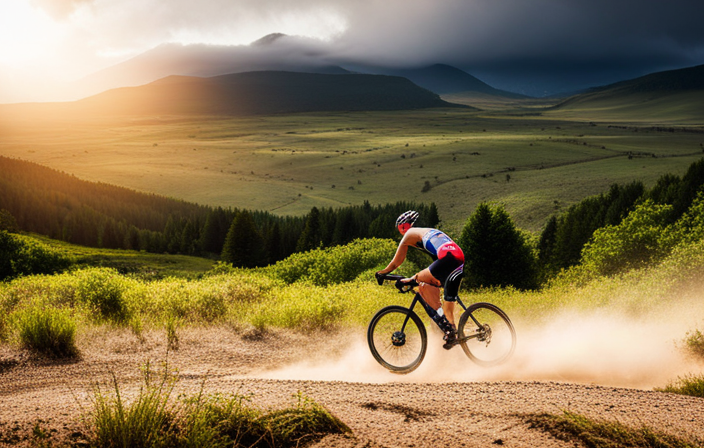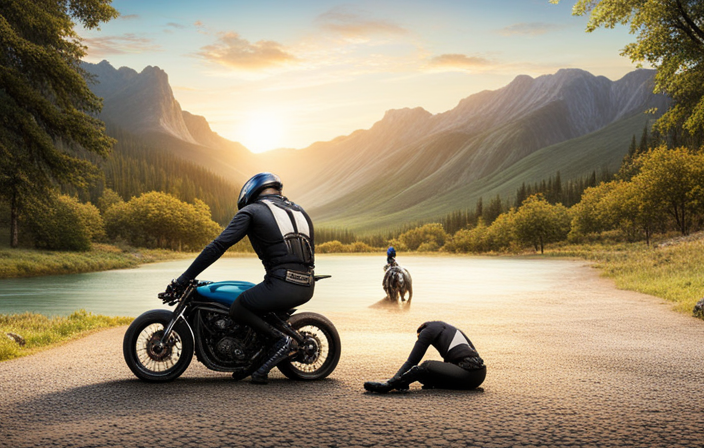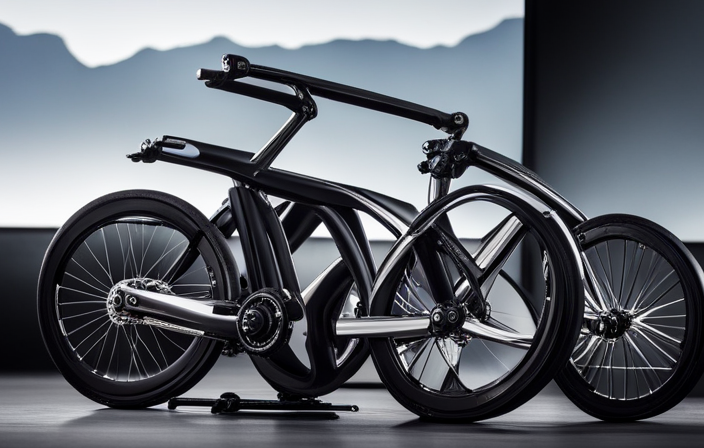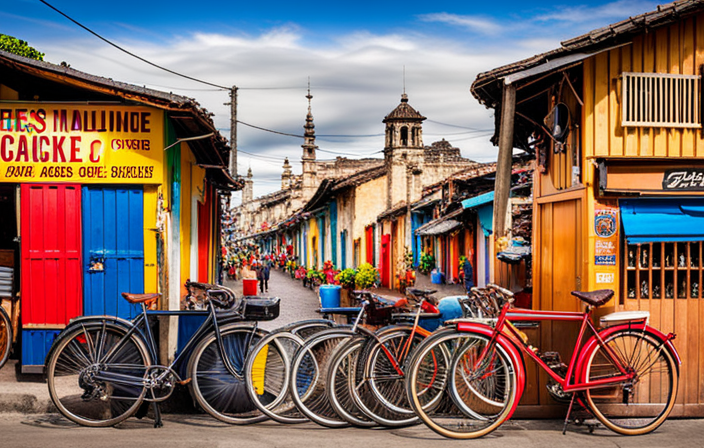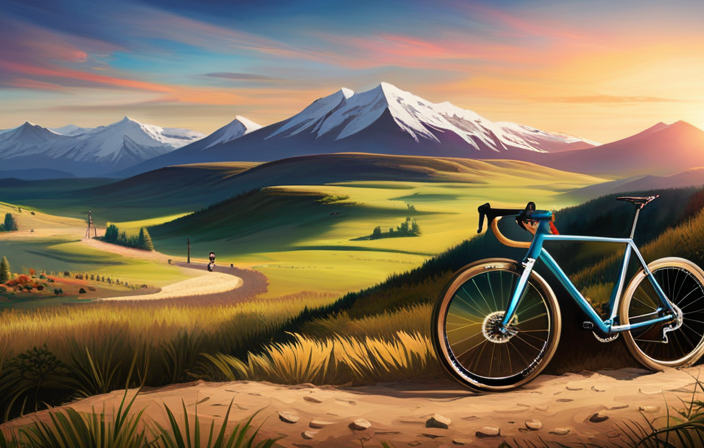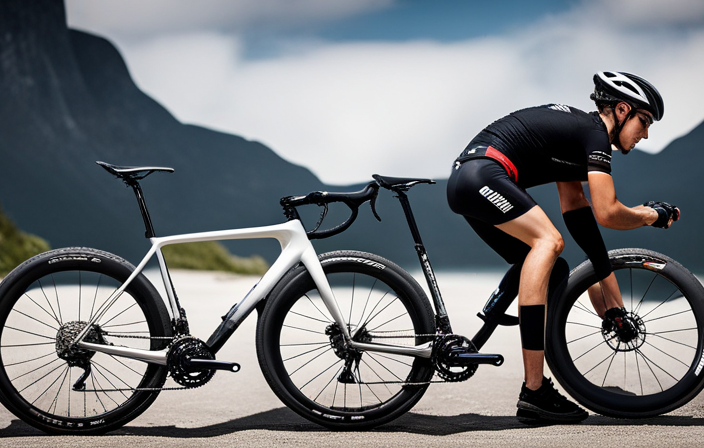Picture the satisfying sound of gravel under your bike tires as you ride through charming countryside, feeling the wind in your hair. Step into the exciting world of gravel bike racing, where adventure meets competition.
In this article, we will explore what exactly a gravel bike race entails, from the types of terrain you’ll encounter to the equipment needed. Whether you’re a seasoned cyclist or a beginner looking for a new challenge, join me as we dive into the thrilling world of gravel bike racing.
Key Takeaways
- Gravel bike races involve racing on unpredictable surfaces and terrains.
- Gravel bike races require specific equipment and gear suited for off-road conditions.
- Gravel bike racing differs from road cycling in terms of terrain, equipment, and techniques.
- Choosing the right gravel bike is crucial for optimal performance in races.
Types of Terrain in Gravel Bike Races
If you’re participating in a gravel bike race, you’ll encounter various types of terrain. The two main types of surfaces you’ll come across are dirt and gravel. Each surface has its own impact on bike handling and speed.
Dirt surfaces can vary from packed dirt to loose soil, depending on the conditions of the race course. This type of terrain requires a different approach when it comes to bike handling as it can be slippery and unpredictable.
Gravel surfaces, on the other hand, consist of small rocks or stones that are compacted together. They provide more traction compared to dirt surfaces, allowing for better control and stability.
The choice between dirt and gravel surfaces also affects your speed during the race. On dirt surfaces, you may need to adjust your riding technique to maintain balance and avoid skidding. This can slow down your overall speed as you navigate through turns and corners cautiously.
Gravel surfaces, while still requiring some caution, allow for faster speeds due to their improved grip.
Transitioning into the next section about equipment and gear needed for gravel bike racing, it’s important to consider how these different terrains impact your ride. Proper equipment such as tires with adequate tread patterns will play a crucial role in maintaining stability and maximizing your performance on both dirt and gravel surfaces without compromising safety.
Equipment and Gear Needed for Gravel Bike Racing
To participate in gravel bike racing, riders must have the necessary equipment and gear. One of the most important aspects to consider is nutrition and hydration strategies. Gravel bike races can be long and demanding, so it’s crucial to fuel your body properly. Carrying enough water and electrolytes is essential to prevent dehydration, especially in hot weather conditions. Additionally, packing energy bars or gels can provide quick bursts of energy during the race.
Choosing the right gravel bike is also vital for a successful race. These bikes are designed specifically for off-road riding on gravel and dirt roads. Look for a bike with wider tires that offer better traction on uneven surfaces. The frame should be sturdy and durable to handle rough terrains.
Transitioning into the next section about differences between gravel bike racing and road cycling, it’s important to note that while both disciplines involve cycling, there are distinct variations in terms of terrain, strategy, and equipment used.
Differences Between Gravel Bike Racing and Road Cycling
One key distinction between gravel bike racing and road cycling is the type of terrain encountered. Gravel bike racing takes place on unpaved surfaces, such as gravel roads, dirt trails, and even singletrack. This varied terrain adds an element of unpredictability and challenge to the race, requiring riders to have a different set of skills compared to road cycling.
When it comes to choosing the right bike for gravel bike racing, there are a few important factors to consider. First and foremost, the bike should be equipped with wider tires that provide better traction and stability on uneven surfaces. Additionally, a more relaxed geometry can help absorb vibrations and bumps commonly found on gravel roads.
The differences in training approach between gravel bike racing and road cycling are also worth noting. While road cyclists often focus on high-intensity intervals and speed work, gravel racers need to prioritize endurance, strength, and handling skills. Long rides on rough terrain can help build the necessary stamina for a successful gravel race.
Transitioning into training tips for gravel bike races: With the right equipment in hand and an understanding of how training approaches differ from road cycling, let’s now dive into some helpful tips for preparing yourself for a challenging gravel race.
Training Tips for Gravel Bike Races
Get ready for your upcoming gravel bike event by incorporating long endurance rides on rough terrain into your training regimen. Gravel bike race preparation requires building both physical and mental strength. To improve your performance, focus on increasing your endurance by gradually increasing the duration and intensity of your rides. Include rides on rough terrain to simulate race conditions and prepare yourself for the challenges you may encounter during the event.
In addition to physical training, mental strategies play a crucial role in gravel bike racing. Mental toughness is essential when faced with difficult terrains or challenging weather conditions. Develop a positive mindset and visualize yourself successfully navigating through the race course. Practice maintaining focus and staying calm under pressure during training rides.
To transition into the subsequent section about nutrition and hydration strategies for long-distance gravel races, it is important to fuel your body properly during training sessions as well as on race day. Optimize your nutrition by consuming a balanced diet that includes carbohydrates, protein, and healthy fats. Stay hydrated throughout your rides by drinking water regularly.
By incorporating these tips into your training routine, you will be better prepared physically and mentally for your upcoming gravel bike race.
Nutrition and Hydration Strategies for Long-Distance Gravel Races
Fueling your body with a balanced diet and staying hydrated are key strategies for long-distance gravel events. Proper nutrition strategies and hydration techniques can help you maintain energy levels, prevent muscle fatigue, and improve overall performance on race day.
When it comes to nutrition, it’s important to focus on consuming a mix of carbohydrates, proteins, and healthy fats. Carbohydrates provide the necessary fuel for endurance activities, while protein helps repair and rebuild muscles. Incorporating sources of healthy fats like avocados or nuts can also provide sustained energy throughout the race. It’s crucial to plan your meals and snacks in advance to ensure you’re getting the right nutrients at the right time.
In terms of hydration, it’s essential to stay well-hydrated before, during, and after the race. Dehydration can lead to decreased performance and even heat exhaustion. To stay properly hydrated, consider using a combination of water and electrolyte-replenishing drinks during the race. Additionally, incorporating foods with high water content like fruits or vegetables can also contribute to your overall hydration.
| Nutrition Strategies | Hydration Techniques |
|---|---|
| Consume carbs for energy | Stay well-hydrated before, during, and after |
| Include protein for muscle repair | Use a combination of water and electrolyte drinks |
| Incorporate healthy fats for sustained energy | Eat foods with high water content |
Transitioning into the next section about choosing the right gravel bike for racing: As important as proper nutrition and hydration are for a successful gravel bike race, choosing the right bike is equally crucial in maximizing your performance on race day.
How to Choose the Right Gravel Bike for Racing
Now that we’ve discussed the importance of nutrition and hydration strategies for long-distance gravel races, let’s shift our focus to choosing the right gravel bike for racing.
As a passionate cyclist, I know how crucial it is to have the perfect bike that suits your needs and enhances your performance on race day.
When selecting a gravel bike for racing, two factors play a significant role: frame materials and essential bike maintenance.
The frame material can greatly impact your race experience, as different materials offer varying levels of comfort, stiffness, and durability. Options like carbon fiber provide a lightweight and responsive ride quality, while steel frames offer excellent durability and vibration dampening properties.
Additionally, ensuring proper bike maintenance is essential for optimal performance during races. Regularly cleaning and lubricating your drivetrain will enhance its longevity and efficiency. Checking tire pressure before each race will help you maintain traction on various surfaces.
In summary, when choosing a gravel bike for racing, consider frame materials that suit your preferences and prioritize essential maintenance practices to keep your bike in top condition.
Now let’s explore techniques for handling unpredictable surfaces without compromising speed or safety.
Techniques for Handling Unpredictable Surfaces
One important aspect of riding on unpredictable surfaces is to maintain a relaxed grip on the handlebars. This allows for better bike control and helps absorb vibrations from rough terrain. When encountering loose gravel or sandy patches, it’s crucial to stay centered on your bike and distribute your weight evenly. This will provide stability and prevent your wheels from sliding out. Additionally, it’s important to keep a steady cadence and avoid sudden movements that could upset the balance of your bike.
Another technique for handling unpredictable surfaces is to anticipate changes in terrain by scanning ahead and choosing the smoothest line possible. This may involve avoiding large rocks, potholes, or other obstacles that could lead to loss of control. Furthermore, adjusting tire pressure can greatly improve traction on different surfaces. Lowering the pressure slightly can increase grip on loose terrain, while increasing it can enhance performance on hard-packed dirt or pavement.
In conclusion, practicing these handling techniques will significantly improve your ability to navigate unpredictable surfaces during gravel bike races. By maintaining a relaxed grip, staying centered, anticipating changes in terrain, and adjusting tire pressure accordingly, you’ll have better control over your bike and be able to tackle any surface with confidence.
This leads us into the next section about strategies for maintaining speed and endurance in gravel bike races.
Strategies for Maintaining Speed and Endurance in Gravel Bike Races
To maintain your speed and endurance in gravel bike races, it’s important to implement effective strategies. One key aspect of maintaining speed is to find the right pacing strategy. It’s easy to get caught up in the excitement at the beginning of a race and go all out, but this can lead to burnout later on. Instead, start at a pace that you know you can sustain for the duration of the race. This will help prevent early fatigue and allow you to steadily build speed as the race progresses.
Another important strategy for maintaining speed and endurance is proper fueling and hydration. Gravel bike races can be physically demanding, so it’s crucial to have a nutrition plan in place. Make sure to consume carbohydrates before and during the race to provide your body with energy. Hydration is also key, especially on hot days or during longer races. Drink plenty of water or electrolyte beverages throughout the event.
In addition to pacing and fueling strategies, it’s important to focus on technique while riding on unpredictable surfaces. Maintaining good body position, keeping a relaxed grip on the handlebars, and using your legs as shock absorbers can help reduce fatigue and improve efficiency.
By implementing these strategies for maintaining speed and endurance in gravel bike races, you’ll be able to maximize your performance throughout the event.
Moving into common challenges faced in gravel bike racing…
Common Challenges Faced in Gravel Bike Racing
Facing common challenges in gravel bike racing can be tough, but with the right strategies and preparation, you’ll be able to overcome them and achieve your goals.
One of the key aspects of preparing for a gravel bike race is implementing effective training techniques. This includes building endurance through long rides on varied terrain, as well as incorporating interval training to improve speed and power. Additionally, it’s important to simulate race conditions during your training by riding on similar surfaces and practicing navigating technical sections.
However, physical preparation is only part of the equation. Mental strategies play a crucial role in overcoming challenges during a gravel bike race. Developing mental toughness is essential to push through fatigue and discomfort. It involves setting realistic goals, staying focused on the present moment, and maintaining a positive mindset when faced with obstacles.
Some common challenges faced in gravel bike racing include unpredictable weather conditions, mechanical issues, and navigation errors. It’s important to have contingency plans for adverse weather situations such as rain or strong winds. Carrying essential tools and spare parts can help address mechanical issues promptly. Familiarizing yourself with the race route beforehand and using GPS devices or cue sheets can minimize navigation errors.
In conclusion, facing common challenges in gravel bike racing requires both physical training techniques and mental strategies. By preparing adequately and staying mentally strong during the race, you can overcome these challenges and perform at your best.
Transitioning into the subsequent section about safety precautions for gravel bike races emphasizes the importance of being prepared for all aspects of this demanding sport without explicitly stating ‘step.’
Safety Precautions for Gravel Bike Races
Make sure you prioritize safety by following these precautions during your gravel bike race. Safety should always be a top concern, so here are some important measures to take:
-
Wear a helmet: This is the most crucial safety precaution for any bike race. Make sure your helmet fits properly and is securely fastened.
-
Train properly: Prioritize training techniques that will enhance your skills and endurance for gravel biking. This will help reduce the risk of accidents due to fatigue or lack of preparation.
-
Use proper equipment: Ensure that your bike is in good working condition and appropriate for off-road riding. Check your brakes, tires, and gears before the race.
-
Prevent injuries: Warm up before the race to avoid muscle strains or pulls. Stretching exercises can also help keep your muscles flexible during long rides.
By taking these safety precautions, you can minimize the risks associated with gravel bike races and enjoy a safer riding experience.
Now let’s explore some notable gravel bike races around the world where you can put these precautions into practice without compromising on fun and adventure!
Notable Gravel Bike Races Around the World
One of the most renowned gravel cycling events globally is the Dirty Kanza, attracting participants from all corners of the world. This challenging race takes place in Emporia, Kansas and offers various distances for riders to choose from.
Another famous gravel bike race is the Belgian Waffle Ride, held in San Diego, California. Known for its brutal course and unpredictable weather conditions, this race attracts both professional cyclists and amateurs alike.
The Crusher in the Tushar is another notable gravel bike race that takes place in Utah’s Tushar Mountains. With a mix of paved roads and dirt tracks, this event provides a unique challenge for participants.
In Europe, the Dirty Reiver in Northumberland, England stands out as one of the top gravel bike races. Set amidst stunning scenery and challenging terrain, this event draws cyclists from across Europe.
The Grinduro series also deserves mention as it combines elements of gravel racing with enduro mountain biking, creating a truly unique experience.
These are just a few examples of famous gravel bike races around the world. Each event offers its own distinct challenges and rewards for participants.
Transitioning into profiles of professional gravel bike racers…
Profiles of Professional Gravel Bike Racers
When it comes to gravel bike racing, it’s not just about the races themselves, but also about the professional racers who compete in them. These athletes dedicate their lives to training and perfecting their skills on the gravel roads.
Let me introduce you to some of the most prominent figures in the world of professional gravel bike racing.
- Ted King: Known for his endurance and consistent performance, Ted King has become a force to be reckoned with in the gravel racing scene.
- Alison Tetrick: With her strong climbing abilities and mental fortitude, Alison Tetrick has proven herself as one of the top female gravel racers.
- Colin Strickland: A true powerhouse on two wheels, Colin Strickland’s aggressive riding style sets him apart from his competitors.
- Amity Rockwell: Amity Rockwell’s technical skills and strategic approach have earned her victories in some of the toughest gravel races.
- Lauren Stephens: As an experienced road racer turned gravel specialist, Lauren Stephens brings her speed and tactical prowess to every race.
These professional athletes employ various training techniques and mental strategies to excel in this demanding discipline. From high-intensity interval sessions to long endurance rides on rough terrain, they push their bodies to new limits. They also focus on mental resilience, staying focused during long races and overcoming challenges along the way.
By understanding the profiles of these professional racers and their training methods, we can gain valuable insights into what it takes to succeed in this sport. Now let’s delve into the benefits that gravel bike racing offers for fitness and adventure…
Benefits of Gravel Bike Racing for Fitness and Adventure
Get ready to discover the exciting ways gravel bike racing can enhance your fitness and provide thrilling adventures.
Gravel bike racing is not only a great way to stay fit, but it also offers unique challenges that can test your mental toughness.
The preparation for a gravel bike race involves training both on and off the bike. You need to build endurance, strength, and agility to tackle the rough terrain and long distances that are characteristic of these races.
In addition to physical fitness, gravel bike racing requires mental toughness. The unpredictable nature of gravel roads and ever-changing conditions demand quick thinking and adaptability. You have to be prepared for anything – from steep climbs to muddy sections – all while maintaining focus and determination.
Participating in gravel bike races not only improves your physical capabilities but also provides thrilling adventures. Exploring new routes amidst beautiful landscapes adds an element of excitement to your rides. Whether you’re racing against others or simply challenging yourself, the sense of accomplishment at the finish line is incredibly rewarding.
So, if you’re ready for a new fitness challenge that will push your limits both physically and mentally, it’s time to consider getting started in gravel bike racing as a beginner.
How to Get Started in Gravel Bike Racing as a Beginner
To start in gravel bike racing as a beginner, you’ll need to begin by researching local events and connecting with experienced riders. Look for beginner-friendly gravel bike races in your area, as these will often have shorter distances and less technical terrain. Once you’ve identified some races that interest you, it’s important to start training specifically for gravel bike racing.
Gravel bike race training should include a mix of endurance rides, interval training, and strength exercises to build both cardiovascular fitness and muscular strength. It’s also crucial to practice riding on different types of terrain, such as gravel roads or dirt trails, to get comfortable with the challenges you may face during a race.
In addition to physical preparation, it can be helpful to connect with other gravel bike racers through online communities or local cycling clubs. These resources can provide valuable advice on training techniques, equipment recommendations, and race strategies. By tapping into these communities, you’ll gain insights from experienced riders who have been through the same journey as beginners like yourself.
With the right research, training plan, and support from fellow cyclists, you’ll be well on your way to becoming a successful gravel bike racer. Now let’s explore some resources and communities for gravel bike racers where you can continue learning and growing in this exciting sport.
Resources and Communities for Gravel Bike Racers
Finding resources and communities that cater specifically to gravel bike racers can greatly enhance your experience and knowledge in this thrilling sport. Here are three valuable resources for gravel bike racers:
-
Training Programs: To improve your performance in gravel bike racing, it’s essential to follow a specialized training program. Many online platforms offer training plans specifically designed for gravel racing, focusing on endurance, strength, and skill development. These programs provide structured workouts and guidance to help you reach your goals.
-
Maintenance and Repair Tips: Gravel bike racing can be tough on your equipment, so it’s crucial to know how to maintain and repair your bike. Online forums and websites dedicated to gravel biking often have sections or articles with tips on cleaning, lubricating, adjusting gears, fixing flat tires, and more. Learning these skills will not only keep your bike in top shape but also save you time and money.
-
Online Communities: Engaging with fellow gravel bike racers through online communities can be extremely beneficial. Joining forums or social media groups allows you to connect with like-minded individuals who share their experiences, advice, and race recommendations. It’s a great way to learn from experienced riders, get inspiration for new routes or races, find training partners, or even organize group rides.
By utilizing these resources and engaging with the gravel biking community, you’ll gain valuable knowledge about different types of training programs tailored for racers while also learning important maintenance and repair tips for keeping your bike in optimal condition throughout the season.
Frequently Asked Questions
What are some common injuries or physical challenges faced by gravel bike racers?
Injury prevention is crucial for gravel bike racers, as the off-road terrain and long distances can pose physical challenges. Common injuries include strains, sprains, and overuse injuries like tendinitis.
To minimize these risks, proper training techniques are important. This includes building strength and endurance through cross-training exercises and gradually increasing mileage.
Additionally, maintaining a balanced diet, staying hydrated, using proper equipment, and wearing protective gear can also help prevent injuries during gravel bike races.
Are there any specific rules or regulations that apply to gravel bike races?
Gravel bike race rules and regulations govern the conduct and safety of participants during these events. These guidelines ensure fair competition and protect the well-being of riders.
Some common rules include mandatory helmet use, adherence to traffic laws, and respect for other riders. Additionally, organizers may implement course-specific regulations such as equipment requirements or time cutoffs.
It is important for participants to familiarize themselves with these bike race rules and gravel race regulations to ensure a smooth and enjoyable event.
How can I improve my bike handling skills for unpredictable surfaces in gravel bike races?
To improve my bike handling skills for unpredictable surfaces in gravel bike races, I focus on specific training techniques.
First, I practice riding on different terrains such as loose gravel and uneven trails to simulate race conditions.
I also work on my balance and stability by doing drills like cornering and quick turns.
Additionally, strength training exercises targeting my core and lower body help improve overall control and stability on rough surfaces.
What are some strategies for maintaining mental focus and motivation during long-distance gravel races?
To maintain focus and mental motivation during long-distance gravel races, I find it helpful to break the race into smaller goals. Setting milestones along the way keeps me focused on the present moment rather than feeling overwhelmed by the distance ahead.
Additionally, maintaining a positive mindset and reminding myself of my training and preparation helps to keep me motivated when fatigue sets in. Regularly refueling and hydrating also contribute to sustained mental focus throughout the race.
Are there any specific recovery techniques or strategies that are recommended for gravel bike racers?
When it comes to recovery techniques for gravel bike racers, there are a few strategies I find helpful.
First, I prioritize proper nutrition and hydration post-race to replenish my energy stores.
I also make sure to stretch and foam roll to alleviate any muscle tightness or soreness.
Additionally, I incorporate active recovery rides into my training schedule to promote blood flow and aid in the healing process.
These techniques are essential for maintaining performance and preventing injuries in this demanding sport.
Conclusion
In conclusion, gravel bike racing offers a thrilling and challenging adventure for both fitness enthusiasts and adrenaline junkies. With its diverse terrain and unique demands, gravel bike races provide an exciting alternative to traditional road cycling.
Whether you’re a beginner looking to start your journey or a seasoned pro seeking new challenges, the world of gravel bike racing has something for everyone. Just imagine the exhilaration of conquering steep climbs and navigating through rugged landscapes like professional racer Sarah Sturm did when she won the Unbound Gravel race in 2021.
So why not grab your bike, embrace the dirt, and join this growing community of gravel bike racers? The possibilities are endless!
